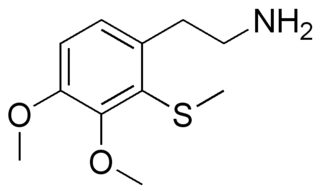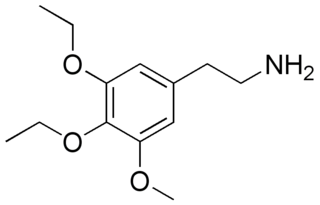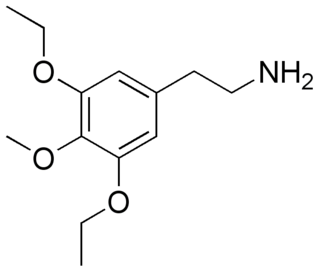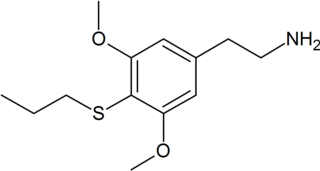
Escaline (3,5-methoxy-4-ethoxyphenethylamine) is a psychedelic drug and entheogen of the phenethylamine class of compounds. Escaline was first synthesized and reported in the scientific literature by Benington, et al., in 1954, but was later re-examined in the laboratory of David E. Nichols, who prepared a series of mescaline analogues that included escaline, proscaline, and isoproscaline. The effects of this and related mescaline analogues in humans were first described by Alexander Shulgin. In his book PiHKAL , Shulgin lists the dosage range as 40 to 60 mg, consumed orally. The duration of action was stated to be 8–12 hours.

Isoproscaline or 4-isopropoxy-3,5-dimethoxyphenethylamine is an analog of mescaline. It is closely related to proscaline and was first synthesized by David E. Nichols. It produces hallucinogenic, psychedelic, and entheogenic effects.

Aleph is a psychedelic hallucinogenic drug and a substituted amphetamine of the phenethylamine class of compounds, which can be used as an entheogen. It was first synthesized by Alexander Shulgin. In his book PiHKAL, Shulgin lists the dosage range as 5–10 mg. According to Shulgin, the effects of aleph typically last for 6 to 8 hours.

3,4-Methylenedioxy-N-hydroxyamphetamine is an entactogen, psychedelic, and stimulant of the phenethylamine and amphetamine chemical classes. It is the N-hydroxy homologue of MDA, and the N-desmethyl homologue of MDHMA. MDOH was first synthesized and assayed by Alexander Shulgin. In his book PiHKAL, Shulgin listed the dosage range as 100–160 mg, and the duration as approximately 3–6 hours. He describes MDOH as being very psychedelic and producing increased pleasure in beauty and nature. He also mentioned several negative side effects also seen with MDMA ("Ecstasy") such as difficulty urinating and internal dryness.

3,4-Methylenedioxy-N-propylamphetamine is a lesser-known psychedelic drug and a substituted amphetamine. MDPR was first synthesized by Alexander Shulgin. In his book PiHKAL, the minimum dosage is listed as 200 mg, and the duration unknown. MDPR is a promoter; by itself it has almost no effects on the mind, but it promotes the effects of hallucinogens, similarly to the closely related MDPH.

TIM, or thioisomescaline, is a series of lesser-known psychedelic drugs similar in structure to mescaline. They were first synthesized by Alexander Shulgin. In his book PiHKAL , none of their durations are known. Very little is known about their dangers or toxicity.

Asymbescaline (3,4-diethoxy-5-methoxyphenethylamine) is a lesser-known psychedelic drug. It is a homolog of mescaline. Asymbescaline was first synthesized by Alexander Shulgin. In his book PiHKAL, the dosage range is listed as 200–280 mg, and the duration listed as 10–15 hours. Asymbescaline produces few to no effects. Very little data exists about the pharmacological properties, metabolism, and toxicity of asymbescaline.

Symbescaline, or 3,5-diethoxy-4-methoxyphenethylamine, is a lesser-known psychedelic drug. It is an isomer of asymbescaline. Symbescaline was first synthesized by Alexander Shulgin. In his book PiHKAL , the dosage is listed as 240 mg, and the duration listed as unknown. Symbescaline causes few effects, which include alertness and a threshold. Very little data exists about the pharmacological properties, metabolism, and toxicity of symbescaline.

Buscaline (3,5-dimethoxy-4-butoxyphenethylamine) is a chemical compound prepared as a possible psychedelic drug. It is an analog of mescaline. Buscaline was first synthesized by Alexander Shulgin. In his book PiHKAL, the minimum dosage is listed as 150 mg, and the duration is "several hours". Buscaline produces no psychedelic or psychoactive effects, but causes heart arrythmia and light diarrhea. It does not cause any visuals or insights. Very little data exists about the pharmacological properties, metabolism, and toxicity of buscaline.

Phenescaline, or 3,5-dimethoxy-4-phenethoxyphenethylamine, is a lesser-known psychedelic drug. It is an analog of mescaline. Phenescaline was first synthesized by Alexander Shulgin. In his book PiHKAL , the minimum dosage is listed as 150 mg, and the duration is unknown. Phenescaline produces a threshold effect. Very little data exists about the pharmacological properties, metabolism, and toxicity of phenescaline.

Metaescaline (3,4-dimethoxy-5-ethoxyphenethylamine) is a lesser-known psychedelic drug. It is an analog of mescaline. Metaescaline was first synthesized by Alexander Shulgin. In his book PiHKAL, the dosage range is listed as 200–350 mg, and the duration listed as 8–12 hours. Metaescaline produces mental insights, entactogenic, MDMA-like effects, and TOMSO-like activation. Little data exists about the pharmacological properties, metabolism, and toxicity of metaescaline, though it has been studied to a limited extent in comparison with other related compounds.

3,4-Methylenedioxy-N-hydroxy-N-methylamphetamine is an entactogen, psychedelic, and stimulant of the phenethylamine and amphetamine chemical classes. It is the N-hydroxy homologue of MDMA ("Ecstasy"), and the N-methyl homologue of MDOH. MDHMA was first synthesized and assayed by Alexander Shulgin. In his book PiHKAL, Shulgin listed the dosage range as 100–160 mg, and the duration as approximately 4–8 hours. He describes MDHMA as causing entactogenic and open MDMA-like effects, easing communication, and increasing appreciation of the senses.

AEM is a lesser-known psychedelic drug. It is an analog of mescaline. AEM was first synthesized by Alexander Shulgin. In his book PiHKAL, the minimum dosage is listed as 220 mg, and the duration unknown. AEM produces few to no effects. Very little data exists about the pharmacological properties, metabolism, and toxicity of AEM.

Allylescaline (4-allyloxy-3,5-dimethoxyphenethylamine) is a lesser-known psychedelic drug. It is closely related in structure to mescaline. Allylescaline was first synthesized by Otakar Leminger in 1972. The compound was later synthesized by Alexander Shulgin and further described in his book PiHKAL. The dosage range is listed as 20–35 mg, and the duration 8–12 hours. Allylescaline produces an entactogenic warmth, an entheogenic effect, and a feeling of flowing energy. Very little data exists about the pharmacological properties, metabolism, and toxicity of allylescaline.
Dimethoxyamphetamine (DMA) is a series of six lesser-known psychedelic drugs similar in structure to the three isomers of methoxyamphetamine and six isomers of trimethoxyamphetamine. The isomers are 2,3-DMA, 2,4-DMA, 2,5-DMA, 2,6-DMA, 3,4-DMA, and 3,5-DMA. Three of the isomers were characterized by Alexander Shulgin in his book PiHKAL. Little is known about their dangers or toxicity.

Thiobuscaline, or 3,5-dimethoxy-4-butylthiophenethylamine, is a lesser-known psychedelic drug.
TOET (methylthio-ethyl-methoxyamphetamines) is a pair of lesser-known psychedelic drugs and substituted amphetamines. 2-TOET and 5-TOET are the 2- and 5-methylthio analogs of DOET, respectively. They were first synthesized by Alexander Shulgin and written up in his book PiHKAL. Very little is known about their dangers or toxicity.

TSB, or thiosymbescaline, is a series of lesser-known psychedelic drugs similar in structure to symbescaline. They were first synthesized by Alexander Shulgin and written up in his book PiHKAL . Very little is known about their dangers or toxicity.

Thioproscaline, or 3,5-dimethoxy-4-propylthiophenethylamine, is a lesser-known psychedelic drug. It is the 4-propylthio analog of mescaline. Thioproscaline was first synthesized by Alexander Shulgin. In his book PiHKAL , the dosage range is listed as 20–25 mg, and the duration listed as 10–15 hours. Thioproscaline causes closed-eye visuals, slight open-eye visuals, and a body load. Very little data exists about the pharmacological properties, metabolism, and toxicity of thioproscaline.

Propynyl (4-propynyloxy-3,5-dimethoxyphenethylamine) is a lesser-known psychedelic drug. It is closely related in structure to mescaline. Propynyl was first synthesized by Alexander Shulgin. In his book PiHKAL, the minimum dosage is listed as 80 mg, and the duration listed as 8–12 hours. Propynyl produces a body load and few to no mental effects. Very little data exists about the pharmacological properties, metabolism, and toxicity of propynyl.




















